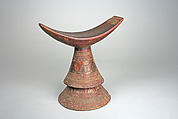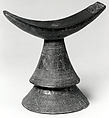Headrest
Not on view
This headrest was used by its owner to preserve his or her elaborate hairstyle during sleep. The reddish-brown object is composed of two elements carved from a single piece of wood: a double-cone base and a crescent-shaped platform. Tapered at the ends, the rest area at top is smooth and retains an oiled surface gained through frequent close contact with the head and hair dressings. Thick parallel grooves are carved at either end. The tiered base that supports it is incised with a series of concentric lines, zig-zags, nested triangles, denticulates (small rectangles), and hatching that run along its perimeter as concentric bands. The upper cone has two standalone designs composed of vertical and horizontal hatched marks on either side of its otherwise unadorned central band. All of the carved designs were heightened with black and red pigment, visible now only as traces. The rough-hewn underside of the headrest is partially hollowed, and retains tool marks. While the general form of the rest appears to have been turned on a lathe, the uneven execution of the incised designs suggest that they were carved by hand.
Personal objects, headrests support the head by cradling it along the jawline, elevating it from the ground. While some regions of central and southern Africa associate headrests with dreaming and divination, they are purely practical in eastern African. Ergonomically, they align the spine, while functionally, they protect intricate hairstyles from dust or from being flattened. Hairstyles, which can take hours to create, are not simply for beautification, but serve as the visual representation of their wearer’s social status, age, rank, and gender. The personal nature of the headrest is reflected in the vocabulary used to describe them in two of Ethiopia’s most commonly spoken languages. In Amharic, they are known as yagertera (“pillow of my land”), while in Oromiffaa, they are called boraatiz (“tomorrow-you”). (Moreno 2015, 194) Even after the end of their useful life, headrests retain the traces of their owners; several examples in the Metropolitan’s collections have a dark sheen on the upper platform and sides, the result of the wood becoming imbued with butter-based hair dressings (käbbe) and other materials used to shape and condition the hair.
The oldest preserved headrests on the African continent were found in Egypt and have been dated to the second and third dynasties of the Old Kingdom (ca. 2649–2150 B.C.). Many of these ancient Egyptian headrest forms—particularly the solid block shaped rest—have parallels in east African headrests created some five millennia later. In southern and central Ethiopia, the use of headrests is believed to have started two to three-hundred years ago. Among the most common forms are the single block, the columned rest with curved platform, and the conical base with curved platform, such as this example. Due to their portable nature, headrests were once used widely among the pastoralist groups of Ethiopia and other regions of eastern Africa. They are less commonly used today because many pastoralists have transitioned to sedentary farming or moved to cities. The diversity of forms in Ethiopian headrests cannot be strictly categorized by gender, or assigned to a single ethnic group; rather, every form is carved by the Oromo, Sidaama, Gurage, and other south-central Ethiopian peoples. Some shapes and ornaments are also shared with groups in nearby Kenya, Uganda, and South Sudan, reflecting the transfer of forms across the region.
Kristen Windmuller-Luna, 2016
Sylvan C. Coleman and Pam Coleman Memorial Fund Fellow in the Department of the Arts of Africa, Oceania, and the Americas
Further Reading
Dewey, William Joseph., Toshiko M. McCallum, Jerome Feldman, and Henrietta Cosentino. Sleeping Beauties: The Jerome L. Joss Collection of African Headrests at UCLA. Los Angeles: Fowler Museum of Cultural History, University of California, 1993.
Moreno, Eduardo López, and Thierry Naudin. Wooden Dreams: East African Headrests from the Eduardo López Moreno Collection. Milan: 5 Continents, 2015.
Nettleton, Anitra C. E. "East African Headrests: Identity, Form and Aesthetics." In African Dream Machines: Style, Identity and Meaning of African Headrests, 187–243. Johannesburg, South Africa: Wits University Press, 2007.
Due to rights restrictions, this image cannot be enlarged, viewed at full screen, or downloaded.
This artwork is meant to be viewed from right to left. Scroll left to view more.



